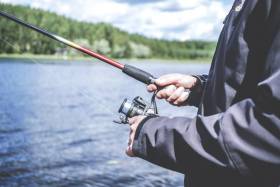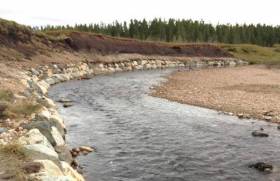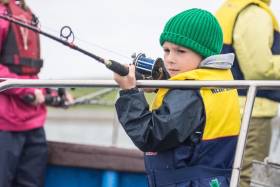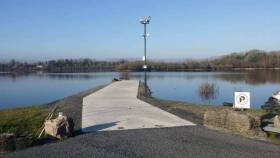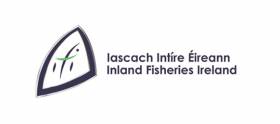Displaying items by tag: National Strategy for Angling Development
New €140,000 Angling Facility In Monaghan Hopes To Attract International Competitions
Enterprise Minister Heather Humphreys was on hand yesterday (Monday 29 July) to help Monaghan County Council open its new €140,000 angling facility at Lough Muckno in Castleblayney.
The upgraded facility, which was funded by Inland Fisheries Ireland (IFI) through its National Strategy for Angling Development, is hoped to attract international angling competitions and visiting anglers.
The fisheries development project saw the opening of an inaccessible angling stretch and the addition of 40 new coarse angling pegs along the shoreline which were required to cater for the lough’s growing number of anglers.
In addition, a new access point to the lough was developed for anglers incorporating 500m of road access, a vehicular access track beside the lake shore and new car parking spaces. IFI provided funding of €105,248 while Monaghan County Council contributed €35,000 to the project.
Minister Humphreys welcomed the upgrades. “Lough Muckno is a renowned angling destination and a valuable amenity to the community at large, offering significant value from both a tourism and recreational perspective. I am delighted to see investment in this facility which ensures it remains at international match standard,” she said.
The project is just one of many fisheries development schemes being delivered across the country under the National Strategy for Angling Development, which IFI touts as the first comprehensives national framework for the development of the angling resource.
The strategy provides opportunities for habitat improvement along with funding which will improve angling access and tourism development.
Cllr Seamus Coyle, Cathaoirleach of Monaghan County Council, said: “The development of this new stretch was required because of the success and popularity of the three previously developed sections on the lake.
“Because these stretches are regularly booked to capacity, it was important to provide another stretch to cater for all those who want to fish the lake and this is where South Lodge comes in.
“I have no doubt that this development will have a significant impact on the local economy and look forward to welcoming more international visitors to Castleblayney”
Dr Ciaran Byrne, IFI chief executive, added: “Lough Muckno has been extremely effective in attracting angling visitors to the town of Castleblaney over the years and this has had a positive economic impact on the area.
“It is fantastic to see rural communities engaging around the angling resource and we continue to support projects nationwide which look to support the improvement of fish habitats and remove barriers to accessing the fisheries resource.”
Creeslough & District Angling Association yesterday (Monday 17 June) opened its new angling facility at Lough na Tooey in North Donegal.
The facility, which was co-funded by Inland Fisheries Ireland (IFI) through its National Strategy for Angling Development, was officially launched by Sean Canney, Minister of State with responsibility for inland fisheries.
The facility at Creeslough is one aspect of a development project delivered by the local angling group which manages a number of salmon and trout fisheries in the area.
This project saw the improvement of angling access and infrastructure across three sites in the area: Lough na Tooey, Glen Lough and the Owencarrow River.
New facilities at Lough na Tooey include a slipway and mooring pontoon, boatshed and car park.
At Glen Lough, a new improved roadway over 1.2km leading to the angling site was constructed, while at Owencarrow, 15 stiles and ladders and 33 fishing stands were erected over 300m of the river bank.
IFI provided funding of over €216,000 with Creeslough & District Angling Association providing match funding of €30,000 to enable the completion of the project.
Minister Canney welcomed the project’s completion, saying: “The new facilities will enable safe and easier access to the fishery for the local community, while also supporting tourism in North Donegal.
“This is a first-class angling site located in a county renowned for its beautiful scenery and superb angling resource. As a result of this project, more local and visiting anglers will be fishing in the area, which in turn will provide both recreational and economic benefits for the community.”
IFI chief executive Dr Ciaran Byrne noted that Creeslough & District Angling Association “initiated and delivered these facilities on the ground by taking a collaborative approach and working across their entire fishery to identify where improvements were needed.
“Rural communities are engaging around the angling resource and demand for support continues apace. We look forward to partnering with more clubs and associations on the delivery of fisheries projects and will announce those successful in securing funding from our latest funding call over the coming months.”
Paddy Boyle of the Creeslough & District Angling Association said: “Fishing as a sport and recreation is dependent on the quality of the natural environment around us. Angling clubs have a role as custodians of this wonderful resource, and we owe it to future generations to look after the fish and their habitat.
“This development at Creeslough is proof of what angling clubs can achieve in partnership with local development agencies and Inland Fisheries Ireland. We asked for their help and got it because we presented them with a well thought-out plan for the conservation and development of our fisheries.”
Inland Fisheries Ireland Launches 2019 Funding Call For Conservation & Development Projects
Inland Fisheries Ireland has announced a new funding call for 2019 with three funding schemes now open to angling clubs and community groups.
The funding has been made available for fisheries conservation projects and development projects nationwide through the National Strategy for Angling Development (NSAD).
Applications are invited from angling clubs, local development associations, tidy towns and others who may be looking to carry out projects.
The 2019 funding call consists of three schemes.
The NSAD Capital Grants Scheme 2019 (€136,000) is aimed specifically at capital improvement works with grants available to groups and individuals looking to improve angling access and infrastructure in their locality.
The Salmon and Sea Trout Rehabilitation, Conservation and Protection Fund focuses on the protection of both salmon and sea trout. It will fund rehabilitation, protection and conservation projects, all of which must focus on salmon or sea trout. This fund replaces the Salmon Conservation Fund and extends it to include both salmon and sea trout with project values starting from €2,000 for awareness projects. The upper limit of €15,000 has been removed.
The Midlands Fisheries Fund (€50,000) will focus on conservation and rehabilitation projects in the midland fisheries permit area. The fund has been created through contributions from the permit income received via the Midlands Fisheries Group permit area.
Sean Canney, Minister of State with responsibility for the inland fisheries sector, said: “Since the inception of the National Strategy for Angling Development, we have invested €3.4 million in fisheries development, protection and conservation projects across the country.
“Progress is being made in the delivery of projects which support vital fisheries conservation and rehabilitation and which enhance Ireland’s angling offering. The fisheries resource should be enjoyed by all and this funding call today once more will help bring angling to the broader community in a conservation focused manner.”
Suzanne Campion of IFI said it looks forward to working with community groups from application to delivery stage on their projects.
“We are already partnering with over a hundred clubs and associations in the delivery of fisheries projects. The commitment of these groups in making a valuable difference to their locality is inspiring.”
For more information about the 2019 funding call, to download an information booklet and to submit an Expression of Interest, visit www.fisheriesireland.ie/funding.
All applicants must apply through the Expression of Interest, which opens today (Tuesday 16 April), to progress to full application. Full applications may be submitted from Monday 20 May with the closing date for applications on Thursday 20 June.
IFI will be hosting information workshops over the coming weeks for those looking for further information or support with the application process:
- Dublin — Citywest Hotel — Monday 29 April
- Cavan — Cavan Crystal Hotel — Tuesday 30 April
- Donegal — Harvey’s Point — Wednesday 1 May
- Ballina — The Great National Hotel — Thursday 2 May
- Galway — Maldron Hotel, Oranmore — Friday 3 May
- Limerick — Maldron Hotel — Tuesday 7 May
- Tralee — Ballygarry Hotel — Wednesday 8 May
- Cork City — Rochestown Park Hotel — Thursday 9 May
- Kilkenny — Ormonde Hotel — Friday 10 May
New Project To Improve Angling Access On River Easkey
#Angling - A new project on the River Easkey in Co Sligo which has improved and developed angling access to the wild salmon river between Sligo and Ballina has now been completed.
The project, which was delivered by River Easkey Angling Association, received support from Inland Fisheries Ireland (IFI) via the National Strategy for Angling Development.
Structures such as footbridges, stiles, and ladders were installed along the river, which is located on the Wild Atlantic Way, while walkway routes on the banks of the salmon and trout fishery were also improved.
The work took place upstream of the famous Workhouse Bridge as part of the second phase of this project which initially involved similar works downstream of the bridge last year.
In total, the project has delivered eight new access points to angling, 13 footbridges ranging from three to four metres in length, and five kilometres of improved trail access.
Sean Canney, Minister of State for responsibility for inland fisheries, said on Wednesday (23 January): “I welcome the continuing efforts of Inland Fisheries Ireland in delivering under the National Strategy for Angling Development in partnership and collaboration with local angling clubs and community groups nationwide.
“Inland Fisheries Ireland committed €23,500 in total to support the Easkey project with €10,000 awarded in 2017 and a further €13,500 granted in 2018.
“I also want to congratulate the River Easkey Angling Association on its excellent development ethos. They are a progressive group that helpfully operates an open policy for holders of a State Salmon License with season and day tickets available for access,” he added.
Suzanne Campion, head of business development at IFI, said: “The River Easkey Angling Association has done fantastic work in developing this area as an angling destination. While completing this project and working closely with our project officers, they have given due diligence to everything from financial and environmental governance to biosecurity considerations ensuring the conservation and protection of this wonderful resource.”
Alan Spencer, assistant secretary of the River Easkey Angling Association, expressed the club’s thanks to Inland Fisheries Ireland’s staff for all their help and support during the project, as well as gratitude to landowners who permitted the club and its contractor access to the river through their property.
Newport Junior Sea Anglers To Benefit From Free Fishing Equipment
#Angling - Sean Canney, Minister of State with responsibility for inland fisheries, has welcomed the success of Newport Sea Angling Club in Co Mayo in securing fishing equipment for junior anglers in the community.
Along with many others around Ireland, including the Finglas Youth Resource Centre in north Dublin, the club received funding from Inland Fisheries Ireland’s National Strategy for Angling Development to help support the recruitment of novices to the pursuit of angling.
Minister Canney said: “Newport Sea Angling Club has a strong junior membership hosting multiple events for young anglers every year. The club provides novice anglers with equipment, tackle, rods and life jackets during junior events.
“This helps in promoting angling to a new generation and also ensures that parents do not have to invest in any equipment until children have tried angling a number of times.
“I am happy to see Inland Fisheries Ireland stand behind the Newport club’s excellent initiative and I am confident their efforts will bring new participants into this healthy outdoor pastime.”
The club’s youth outreach initiatives attract many junior anglers with up to 60 juniors attending their National Junior Competition every year.
This new equipment will assist the club in training novice anglers in sea angling skills. In addition to fishing equipment, the club will also purchase a projector and screen for the club which will be used to assist them in theoretical training sessions.
Declan Moran of Newport Sea Angling Club said: “We hope that we can remove any pressure on parents or guardians to purchase angling equipment at the outset until their child has tried the pursuit and intends to continue with it. We believe this is one of the reasons why the club is so successful in introducing many young novice anglers to sea fishing each year.
“At Newport Sea Angling Club, we are committed to helping the next generation of anglers by passing on the necessary angling skills and introducing them to the pursuit in a safe and friendly environment.”
Suzanne Campion, head of business development at Inland Fisheries Ireland, said: “Newport Sea Angling Club has a long history of supporting junior anglers with a number of popular junior events held in Newport every year. We are delighted to support the club through the National Strategy for Angling Development fund to enable the purchase of more fishing equipment.
“I would like to take this opportunity to congratulate them on their work to date in recruiting new junior members and we look forward to seeing even more growth in sea angling in Newport and the surrounds in years to come! By increasing participating in angling among the next generation, we are securing the future of our precious and valuable natural resource.”
Young Dubliners In Finglas Get Hooked On Angling
#Angling - Finglas Youth Resource Centre (FYRC) has been awarded €4,800 to purchase new equipment for angling.
The centre, which works with young people from ages 10 to 24 in the Finglas area, delivers a fishing programme which Inland Fisheries Ireland (IFI) has proved to be extremely popular with local participants.
Funding has now been granted to the centre by IFI to support it in engaging young people around the pursuit.
FYRC first introduced a fishing programme to the community in the summer of 2016. The high level of demand resulted in a need for more resources and equipment to ensure its delivery.
This new equipment will allow the programme to expand its reach into the greater Finglas area and provide better angling opportunities for participants.
IFI granted the funding through its National Strategy for Angling Development which aims to ensure that Ireland’s fish stocks and angling infrastructure are protected and enhanced with a view to ensuring a sustainable habitat and the delivery of the economic, health and recreational benefits which they offer to communities across Ireland.
It’s hoped to grow the angling sector’s socio-economic contribution of €836 million per year by an additional €60 million annually through the strategy.
This would be achieved by driving angling participation among domestic and overseas visitors, which in turn is supported by improving access to fishing and developing angling infrastructure.
“It is fantastic that there is such a demand from young people in Finglas to access angling and to enjoy it as a pursuit on an ongoing basis,” said IFI’s Suzanne Campion.
“Finglas Youth Resource Centre provides valuable support and guidance to young people and we are delighted to support and work alongside them in promoting angling in the area.
“Angling is a pursuit that can be enjoyed at any age or ability, in a group or in solitude and it offers many health and wellbeing benefits.
“We hope that the young people who pass through the doors of Finglas Youth Resource Centre in the coming years will reap the many recreational rewards which our fisheries resource has to offer.”
Funding Available For Angling Projects & Events In 2019
#Angling - Inland Fisheries Ireland (IFI) has launched its Sponsorship Programme for 2019 and is now inviting applications from suitable angling events and initiatives nationwide.
The programme, which is one of the funding mechanisms of the National Strategy for Angling Development, awarded funding to 62 Irish angling events and 10 teams representing Ireland in overseas international events to the combined value of €30,000 last year.
Sean Canney, Minister of State with responsibility for the inland fisheries sector, said: “I want to congratulate Inland Fisheries Ireland for making financial support available once again in 2019 for projects and events which will support novice and junior anglers and help grow angling tourism.
“I support Inland Fisheries Ireland’s aim to help ‘bring angling to the people’ by supporting initiatives which help remove barriers to those looking to try fishing or for younger people who already enjoy the pursuit. IFI is working to support events and initiatives which promote the angling tourism product with a view to growing angler tourist numbers and economic return.”
The Sponsorship Programme supported 17 initiatives by local angling clubs during the year which included junior competitions, summer leagues, disability outreach programmes and angling coaching workshops.
In total, 630 juvenile and novice anglers participated in these initiatives and almost 300 of them joined a fishing club for the first time following their participation in a local engagement project.
In addition to junior and novice angling projects, there were 28 large scale angling events supported via the programme in 2018 with 1,866 experienced anglers taking part. Over 800 anglers travelled from outside Ireland to participate in these angling competitions, IFI says.
The events and initiatives which are eligible for funding in 2019 include:
- Large international competitions held in Ireland which showcase Ireland’s angling and contribute to local economies, supporting jobs and businesses.
- Novice angler events and training courses which increase participation in angling including funding of transport hire for participants to facilitate attendance at novice angler events.
- Initiatives to promote fisheries awareness and/or conservation and protection of the inland fisheries and sea angling resource.
- Initiatives promoting angling as a key Irish tourism activity, such as via high quality angling promotional videos, seminars, coaching, training, workshops, etc.
- Juvenile and minority angling teams representing Ireland at international events both home and abroad.
“Our 2019 Sponsorship Programme will play an important role in driving angling participation among novice and junior anglers,” said Suzanne Campion, head of business development at IFI. “The Sponsorship Programme has awarded €30,000 per year over the past five years to angling clubs and groups nationwide to help in the delivery of local angling events.
“In addition to supporting those who are casting for the first time, we also have a unique opportunity to grow our angling tourism product. The Sponsorship Scheme offers clubs and associations an incentive to engage overseas anglers to visit our renowned wild fisheries and to enjoy fishing here in a conservation focused manner.”
Applications for funding from the Sponsorship Scheme are now invited from angling clubs, associations or any local group organising an angling initiative.
The scheme will remain open for funding applications until Friday 18 January with applications for equipment, staff support and biosecurity assistance available throughout the year. Awards will be subject to budget availability and adherence to the scheme requirements.
To find out more and to apply, see the Sponsorship Programme page on the IFI website.
Improvement Works Completed At Popular Co Mayo Angling Destination
#Angling - Ballinrobe & District Anglers have successfully completed a project which will greatly improve access to a popular angling destination at Cushlough Bay in Co Mayo.
The project was funded by Inland Fisheries Ireland (IFI) via the National Strategy for Angling Development (NSAD) Fund. The location at Cushlough Bay, off Lough Mask near Ballinrobe is used by domestic and visiting international anglers alike.
The project saw improvement works completed on the angling club’s carpark to make it safe and accessible for anglers. This included resurfacing and realigning of the carpark, as well as the provision of security fencing around the perimeter.
The club was awarded €21,263 from IFI to carry out the work. The funding was granted in June, after the club completed its corporate governance requirements, with the project at completion stage just a few weeks later.
IFI granted support under its National Strategy for Angling Development (NSAD) which aims to ensure that Ireland’s fish stocks and angling infrastructure are protected and enhanced for the economic value and recreational benefit which they offer to communities across Ireland.
The fisheries resource is worth €836 million to the Irish economy annually and supports upwards of 11,000 jobs, often in rural and peripheral communities.
In addition to the funding provided under the NSAD, Ballinrobe & District Anglers and the World Cup Trout Fly Championship Committee provided €6,641 to upgrade the slipway as an extra part of the project.
Sean Canney TD, Minister of State with responsibility for the inland fisheries sector, said: “Investment in angling access and infrastructure is a key component of the current round of NSAD funding and the Ballinrobe club has demonstrated that, working in partnership with Inland Fisheries Ireland and underpinned by significant grant aid, valuable community driven projects will be delivered.
“The project will be of major benefit to local, visiting and international anglers and will define Cushlough Bay as a top class venue for social and competitive angling and can assist in attracting international events.”
Suzanne Campion, head of business development at IFI, added: “Accessibility and safety is a priority if our inland fisheries are to be enjoyed by everyone. I am delighted that this project is complete in Ballinrobe at an important angling location which has both recreational and socio economic benefit to the local community.”
Kevin Egan, chair of Ballinrobe & District Anglers, commented: “This is an outstanding project which we are delighted to complete. The funding from the National Strategy for Angling Development allowed us to upgrade the parking facility which will be of benefit for local anglers and tourist anglers.”
#Angling - The Salmon Conservation and Midland Fisheries Funds are now open to projects for habitat restoration and conservation, as announced earlier this week by Sean Kyne TD, Minister of State with responsibility for inland fisheries.
The closing date for applications to these schemes, as part of Inland Fisheries Ireland’s (IFI) National Strategy for Angling Development, is Thursday 12 July.
The National Strategy for Angling Development aims to ensure that Ireland’s fish stocks and angling infrastructure are protected and enhanced with a view to ensuring a sustainable habitat and delivering the economic, health and recreational benefits they offer to communities across Ireland.
The Salmon Conservation Fund is generated from the sale of salmon and sea-trout licences and reinvested in projects that will assist in the conservation of salmon.
“As the Conservation Fund is financed via a portion of licence sales for both Salmon and Sea Trout, I asked IFI to develop a revised scheme that will include sea trout conservation projects and update the existing salmon-only scheme,” Minister Kyne said.
“As a first step to realising a full scheme for sea trout, this year’s fund is open to accepting a pilot sea trout project for the Waterville area.”
Applications to the Salmon Conservation and Midland Fisheries Funds must relate to conservation habitat improvement projects.
Applications may be made online and are invited for projects that are ‘ready to go’, ie that have all the necessary paperwork and permissions in place and can move to delivery following successful progression through evaluation and award stages. Such projects would include, for example, a second or subsequent phase of an existing scheme.
Successful applications must meet the requirements of the IFI Environmental Assessment process.
IFI’s current priority is to ensure projects already awarded funding under the recent National Strategy for Angling Development schemes up to and including 2017 are completed and project officers continue to assist applicants to bring these projects to delivery phase.
To this end, project officers are engaging with groups and other Government agencies. Ready-to-go projects should be timed to complete by end of September 2018.
Meanwhile, IFI has issued an appeal to farmers to remain vigilant during the summer months when harvesting silage and spreading slurry to avoid water pollution and the loss of nutrients into rivers, lakes and other watercourses.
The appeal comes on the back of last week’s major fish kill in Claremorris, where over 1,000 wild brown trout and other species died as a result of a suspected agricultural silage leak.
Silage operations will be ongoing all summer and silage effluent has the potential to cause devastating pollution in streams and rivers.
Such effluent is a significant polluting substance, starving fish and invertebrate life of oxygen, resulting in potentially massive fish kills if it enters a watercourse.
With some rivers low during summertime with little dilution capacity, the effect of a small leak can cause huge damage.
IFI is advising farmers to follow its simple six-point plan to ensure good farmyard management and reduce their risk of polluting:
- Use round bales as the most environmentally friendly way to store silage.
- If a silage pit is being used, ensure it is properly sealed to prevent leakage from under the slab.
- Carry out slurry spreading in dry weather and never when heavy rain is forecast.
- Never spread slurry close to a watercourse, be aware of the slope of land to the watercourse.
- Do not clean tanks beside any watercourse, stream or a river.
- Do not allow any effluent or washings to enter any rainwater gully.
Public Consultation On National Strategy For Angling Development
#Angling - Minister for Natural Resources Joe McHugh has today (Monday 30 November) launched the public consultation on the National Strategy for Angling Development (NSAD).
Prepared by Inland Fisheries Ireland (IFI), the NSAD is the first comprehensive national framework for the development of Ireland's angling resource.
It is intended that the strategy will deliver a wide-ranging set of investments, innovations and promotions over the coming years.
This will ensure that Ireland's fish stocks and angling infrastructure are protected and enhanced for both their economic value and their recreational benefit to the communities and visitors they serve across the country.
“This strategy is necessary and timely to protect our wonderful inland fisheries and sea angling resources in their own right but also to safeguard and grow further the 11,350 jobs supported and €836 million contributed annually to Ireland’s economy by recreational angling," said Minister McHugh.
“These jobs and economic activity occur primarily in rural and peripheral areas of the country. The strategy supports the Government’s rural development, tourism and social inclusion objectives, and I urge all stakeholders to participate in the consultation process.”
IFI chief executive Dr Ciaran Byrne thanked all those who took part in the initial consultation process. “The inputs from stakeholders have been invaluable to Inland Fisheries Ireland in the preparation of the National Strategy for Angling Development. We look forward to working with all of our stakeholders in progressing the strategy.”
In accordance with Article 13(1)(b) of the European Communities (Environmental Assessment of Certain Plans and Programmes) Regulations 2004 (S.I. 435), as amended by the European Communities (Environmental Assessment of Certain Plans and Programmes)(Amendment) Regulations 2011, Inland Fisheries Ireland has prepared:
- A Strategic Environmental Assessment (SEA) Environmental Screening Report of the likely significant effects on the environment of implementing the Strategy, in accordance with Directive 2001/42/EC of the European Parliament and Council of 27 June 2001 on the assessment of the effects of certain plans and programmes on the environment as transposed into Irish law by the European Communities (Environmental Assessment of Certain Plans and Programmes) Regulations 2004 as amended.
- A Habitats Directive Screening Statement for Appropriate Assessment (AA), pursuant to Article 6 of Council Directive 92/43/EEC of 21 May 1992 on the conservation of natural habitats and of wild fauna and flora as transposed into Irish law by the European Communities (Birds and Natural Habitats) Regulations 2011.
The NSAD screening reports and supporting documents are available for viewing and downloading HERE; from IFI, 3044 Lake Drive, Citywest Business Campus, Dublin 24, D24 Y265; or at IFI offices countrywide (please see www.fisheriesireland.ie for addresses and maps).
Written submissions or observations should be sent to [email protected] or NSAD Consultation, 3044 Lake Drive, Citywest Business Campus, Dublin 24, D24 Y265 and must be received no later than Monday 4 January 2016.
For more information visit www.fisheriesireland.ie.



























